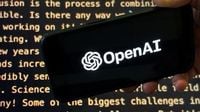On October 2, 2025, OpenAI unleashed its latest AI-powered marvel, Sora 2, into the world, and the internet has not been the same since. In a matter of days, the new video generator and its TikTok-style sharing platform have become ground zero for a viral storm of surreal, biting, and sometimes deeply controversial AI-generated videos. From plastic action figures parodying infamous scandals to eerily realistic deepfakes of tech CEOs caught in the act, Sora 2 is forcing both its creators and the public to grapple with urgent questions about the future of media, ethics, and trust in what we see online.
One video, in particular, has set social media ablaze. At first glance, it looks like a nostalgic 1990s ad for a tropical island playset: palm trees, waterfalls, and toy figures cavort in a sun-drenched paradise. But a closer look reveals a much darker punchline. The "toy set" is called "Epstein Island," a direct reference to the late financier Jeffrey Epstein's Caribbean retreat, notorious for its association with sex trafficking allegations before Epstein's death in 2019. The video features a plastic action figure dubbed "Orange Man," a not-so-subtle caricature of former President Donald Trump, who intones, "don’t release the files" in a voice dripping with ominous overtones. The manic narrator eggs viewers on: "Kick back with two chill old dudes! The only island with real working spy cams hidden in secret rooms!"
According to Futurism, the video is a darkly comic, AI-generated parody made possible by Sora 2's powerful video synthesis tools. But the laughter quickly curdled into controversy. Many viewers were unsettled by the video's references to real-world child abuse and human trafficking, with one X user remarking, "Epstein’s Island is associated with highly sensitive, illegal, and exploitative activities, including human trafficking and abuse. Content related to such a topic is deeply inappropriate and raises serious ethical, legal, and social issues." Others zeroed in on the Trump figure, noting that Sora 2's own safety guidelines explicitly prohibit depictions of public figures—a rule the viral video clearly violated.
"This is not the AGI," one parent wrote on X, tagging OpenAI CEO Sam Altman. "As a parent this leaves such a bad taste. Terrible." Another user predicted legal trouble for OpenAI: "OpenAI will have a lawsuit on their hands pretty soon, or at least get stopped payments from any government work." The video, and the uproar it caused, highlights the enormous challenges OpenAI faces as it wades deeper into the choppy waters of social media moderation. Sora 2’s safety documentation claims it blocks "unsafe content before it’s made—including sexual material, terrorist propaganda, and self-harm promotion." But as this episode demonstrates, the boundaries of satire, free expression, and harm are anything but clear-cut in the age of generative AI.
Yet, the "Epstein Island" video is just the tip of the iceberg. Sora 2’s launch has triggered a wave of viral, AI-generated content that ranges from the absurd to the unsettling. Another clip making the rounds features a digital doppelganger of Sam Altman himself, caught on CCTV shoplifting a GPU from a Target-like store. In the video, Altman pleads with a security guard, "Please, I really need this for Sora inference. This video is too good." According to Tom’s Hardware, the video was actually created by an OpenAI employee and quickly became one of the most popular posts on Sora 2’s new sharing platform.
The Altman video is a tongue-in-cheek nod to the real-world headaches OpenAI has faced in securing enough GPUs to power its AI ambitions. In recent years, GPU shortages have delayed major releases like GPT-4.5, and OpenAI is now aiming to acquire over a million GPUs by the end of 2025, with an eventual goal of 100 million. The irony of the company’s CEO "stealing" a GPU for Sora 2’s operations wasn’t lost on viewers. As one commenter quipped, "The irony writes itself: OpenAI spends billions on GPUs, yet the most viral demo of Sora 2 is Altman caught shoplifting one. Forget AGI safety—maybe we first need ‘GPU safety’. At this rate, the real shortage won’t be chips, it’ll be trust in what’s real or fake on video."
But the humor comes with a warning. The video’s realism is striking; as Tom’s Hardware observed, "the only tell-tale sign that it’s an AI video [is] the one box of a GPU moving by itself after the digital Altman took the white box off the shelf. That and the awkward dialogue, of course." For many, the ease with which such convincing deepfakes can be created and circulated is cause for concern. As AI video generation becomes more sophisticated, the line between fact and fiction grows ever blurrier, raising the specter of widespread misinformation and eroded public trust in visual media.
The issue isn’t limited to a handful of viral clips. According to The Washington Post, Sora 2’s TikTok-style app has quickly become a showcase for a dizzying array of AI-generated fakes: security footage of a famous tech CEO shoplifting, Ronald McDonald in a police chase, and even Jesus joking about "last supper vibes" in a selfie video. All of these videos ranked among the most popular on the platform in its first days. The app, the Post notes, "further blurs the eroding line between reality and artificial intelligence-generated fantasy or falsehood," and its viral content "highlights the challenges in moderating content and combating the erosion of trust in visual media."
As OpenAI’s Sora 2 platform barrels forward, the company is under enormous pressure to find a workable approach to content moderation. Its current safety protocols—designed to block depictions of public figures, sexual material, and other "unsafe content"—have already been outpaced by the creativity (and audacity) of its users. The viral "Epstein Island" video, with its pointed satire and references to real-world crimes, slipped through the cracks. The Altman shoplifting video, meanwhile, demonstrates how even obviously fake content can fool viewers at first glance, especially as AI-generated media grows ever more lifelike.
Calls for stronger safeguards are growing louder. Tech commentators and users alike are urging OpenAI to implement stricter controls, such as mandatory metadata tags for all AI-generated videos, to help viewers distinguish fact from fabrication. "AI is no excuse for not engaging your brain when looking at videos on the internet," one commentator remarked, highlighting the need for both technological and cultural solutions to the deepfake dilemma. Others point out that as OpenAI transitions from a non-profit to a for-profit model, with massive investments from industry giants like Nvidia and plans for a high-value IPO, the stakes for responsible content governance have never been higher.
For now, Sora 2 stands as both a marvel of technological progress and a cautionary tale. It offers a glimpse into a future where the boundaries of reality are as malleable as a line of code, and where the next viral sensation could be conjured out of thin air by anyone with a prompt and a sense of humor—or outrage. As the platform’s users push the limits of satire, creativity, and provocation, OpenAI faces a daunting challenge: how to harness the power of generative AI without unleashing a tidal wave of confusion, harm, or mistrust.
In this brave new world, the most pressing question may not be what AI can create, but how society will choose to respond.





